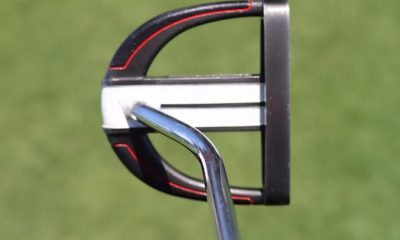Instruction
Fix early extension: 3 exercises to get your a** in gear

It’s pretty common knowledge that “early extension” is a problem for golfers everywhere, but how does it affect your body and your game? And what can you do to fix it?
First, let’s look at early extension in its most simple form as a physical issue rather than a technical issue.
During the swing, we are asking our body to not only create force, but also resist a number of different forces created by the aggressive rotational pattern we call a golf swing. The problem comes down to each player’s unique dysfunction which will likely include bad posture, weak glutes or a locked out thoracic spine for example.
So when we then ask the body to rotate, maintain spine angle, get the left arm higher, pressure the ground, turn our hips to the target (to name a few) a lot of mobility, strength and efficiency are required to do all of this well.
And not everyone, well actually very few of us, has the full capability to do all of this optimally during the swing. The modern lifestyle has a lot to do with it, but so does physiology and it has been shown that tour players as well as everyday golfers suffer from varying levels of dysfunction but can ultimately get by relative to learned patterns and skill development.
But for the majority of players early extension leads to one or more of the following swing faults:
- Loss of spine angle/posture. During the swing, a player will ‘stand up’ coming out of their original and desired spine angle, this alters the path and the plane of the club.
- “Humping” the ball. Johnny Wunder’s preferred term for the forward and undesirable movement of the lower body closer to the ball.
Lack of rotation during the swing occurs due to the shift in the center of gravity caused by the loss of posture as your body does its best to just stay upright at all.
Ultimately, early extension leaves us “stuck” with the club too far behind us and nowhere to go—cue massive high push fade or slice going two fairways over (we’ve all been there) or a flippy hook as your body backs up and your hands do whatever they can to square it up.
Not only is this not a good thing if you want to hit a fairway, it’s also a really bad way to treat your body in general.
As a general rule, your body works as a system to create stability and mobility simultaneously allowing us to move, create force, etc. When we can’t maintain a stable core and spinal position or force is being transferred to an area that shouldn’t be dealing with it, we get issues. Likely, this starts with discomfort, possibly leading to prolonged pain, and eventually injury.
The body has a whole lot to deal with when you play golf, so it’s a good idea to start putting in the work to help it out. Not only will you reduce your risk of injury, but you’ll also likely play better too!
So we have three simple exercises for you here that you can do at home, or anywhere else, that will help you with the following elements
- Posture
- Core strength
- Glute function
- Thoracic mobility
- Asymmetrical balance
- Ground force development
#1: Forward lunge with rotation
- Standing tall, core engaged with a club in front of your chest, take a reasonable step forward.
- Stabilize your lead knee over your front foot and allow your trail knee to move down towards the ground, trying to keep it just above the surface.
- Maintaining your spine angle, rotate OVER your lead leg (chest faces the lead side) with the club at arm’s length in front of your torso keeping your eyes facing straight forwards.
- Rotate back to center, again with great control, and then step back to your original standing position.
- Repeat on other leg.





#2: Bird dog
- Get down on all fours again focusing on a quality, neutral spine position.
- Extend your left arm forward and your right leg backward.
- Control your breathing and core control throughout as we test balance, stability and core activation.
- Hold briefly at the top of each rep and return to start position.
- Repeat with right arm and left leg, alternating each rep.
- If this is difficult, start by working arms and legs individually, only life 1 arm OR 1 leg at a time but still work around the whole body.



#3: Jumping squat
- Start with feet shoulder-width apart, eyes fixed forward.
- Engage your squat by sending your knees forwards and out to create pressure and torque, whilst sending your hips down and back.
- Squat down as far as possible whilst maintaining a neutral spine, active core and heels on the ground.
- As you naturally come out of the squat, push the ground away using your whole foot, creating as much speed and force as possible as you jump in the air.
- Land with excellent control and deceleration, reset and repeat.



Got 10 minutes? Sample workout
3 Rounds
- 10 Forward Lunge with Rotation (5 each leg)
- 10 Bird Dog (5 Each side or 5 each limb if working individually)
- 5 Jumping Squats
- 1 Minute Rest
If you can take the time to make this a part of your routine, even just two or three times per week, you will start to see benefits all round!
It would also be a perfect pre-game warm-up!
And one thing you can do technically? Flare your lead foot to the target at address. A huge majority of players already do this and with good reason. You don’t have to alter your alignment, rather keep the heel in its fixed position but point your toes more to the target. This will basically give you a free 20 or 30 degrees additional lead hip rotation with no real side-effects. Good deal.
This is a great place to start when trying to get rid of the dreaded early extension, and if you commit to implementing these simple changes you can play way better golf and at least as importantly, feel great doing it.
To take your golf performance to new levels with fitness, nutrition, recovery, and technical work, check out everything we do on any of the following platforms.
- LIKE35
- LEGIT2
- WOW0
- LOL0
- IDHT0
- FLOP3
- OB4
- SHANK13
Instruction
Clement: Laid-off or perfect fade? Across-the-line or perfect draw?

Some call the image on the left laid off, but if you are hitting a fade, this could be a perfect backswing for it! Same for across the line for a draw! Stop racking your brain with perceived mistakes and simply match backswing to shot shape!
- LIKE0
- LEGIT0
- WOW0
- LOL0
- IDHT0
- FLOP0
- OB0
- SHANK1
Instruction
The Wedge Guy: The easiest-to-learn golf basic

My golf learning began with this simple fact – if you don’t have a fundamentally sound hold on the golf club, it is practically impossible for your body to execute a fundamentally sound golf swing. I’m still a big believer that the golf swing is much easier to execute if you begin with the proper hold on the club.
As you might imagine, I come into contact with hundreds of golfers of all skill levels. And it is very rare to see a good player with a bad hold on the golf club. There are some exceptions, for sure, but they are very few and very far between, and they typically have beat so many balls with their poor grip that they’ve found a way to work around it.
The reality of biophysics is that the body moves only in certain ways – and the particulars of the way you hold the golf club can totally prevent a sound swing motion that allows the club to release properly through the impact zone. The wonderful thing is that anyone can learn how to put a fundamentally sound hold on the golf club, and you can practice it anywhere your hands are not otherwise engaged, like watching TV or just sitting and relaxing.
Whether you prefer an overlap, interlock or full-finger (not baseball!) grip on the club, the same fundamentals apply. Here are the major grip faults I see most often, in the order of the frequency:
Mis-aligned hands
By this I mean that the palms of the two hands are not parallel to each other. Too many golfers have a weak left hand and strong right, or vice versa. The easiest way to learn how to hold the club with your palms aligned properly is to grip a plain wooden ruler or yardstick. It forces the hands to align properly and shows you how that feels. If you grip and re-grip a yardstick several times, then grip a club, you’ll see that the learning curve is almost immediate.
The position of the grip in the upper/left hand
I also observe many golfers who have the butt of the grip too far into the heel pad of the upper hand (the left hand for right-handed players). It’s amazing how much easier it is to release the club through the ball if even 1/4-1/2″ of the butt is beyond the left heel pad. Try this yourself to see what I mean. Swing the club freely with just your left hand and notice the difference in its release from when you hold it at the end of the grip, versus gripping down even a half inch.
To help you really understand how this works, go to the range and hit shots with your five-iron gripped down a full inch to make the club the same length as your seven-iron. You will probably see an amazing shot shape difference, and likely not see as much distance loss as you would expect.
Too much lower (right) hand on the club
It seems like almost all golfers of 8-10 handicap or higher have the club too far into the palm of the lower hand, because that feels “good” if you are trying to control the path of the clubhead to the ball. But the golf swing is not an effort to hit at the ball – it is a swing of the club. The proper hold on the club has the grip underneath the pad at the base of the fingers. This will likely feel “weak” to you — like you cannot control the club like that. EXACTLY. You should not be trying to control the club with your lower/master hand.
Gripping too tightly
Nearly all golfers hold the club too tightly, which tenses up the forearms and prevents a proper release of the club through impact. In order for the club to move back and through properly, you must feel that the club is controlled by the last three fingers of the upper hand, and the middle two fingers of the lower hand. If you engage your thumbs and forefingers in “holding” the club, the result will almost always be a grip that is too tight. Try this for yourself. Hold the club in your upper hand only, and squeeze firmly with just the last three fingers, with the forefinger and thumb off the club entirely. You have good control, but your forearms are not tense. Then begin to squeeze down with your thumb and forefinger and observe the tensing of the entire forearm. This is the way we are made, so the key to preventing tenseness in the arms is to hold the club very lightly with the “pinchers” — the thumbs and forefingers.
So, those are what I believe are the four fundamentals of a good grip. Anyone can learn them in their home or office very quickly. There is no easier way to improve your ball striking consistency and add distance than giving more attention to the way you hold the golf club.
More from the Wedge Guy
- The Wedge Guy: Golf mastery begins with your wedge game
- The Wedge Guy: Why golf is 20 times harder than brain surgery
- The Wedge Guy: Musings on the golf ball rollback
- LIKE87
- LEGIT13
- WOW6
- LOL1
- IDHT0
- FLOP4
- OB1
- SHANK8
Instruction
Clement: Stop ripping off your swing with this drill!

Not the dreaded headcover under the armpit drill! As if your body is defective and can’t function by itself! Have you seen how incredible the human machine is with all the incredible feats of agility all kinds of athletes are accomplishing? You think your body is so defective (the good Lord is laughing his head off at you) that it needs a headcover tucked under the armpit so you can swing like T-Rex?
- LIKE0
- LEGIT2
- WOW2
- LOL0
- IDHT0
- FLOP0
- OB0
- SHANK2
-

 19th Hole2 weeks ago
19th Hole2 weeks agoDave Portnoy places monstrous outright bet for the 2024 Masters
-

 19th Hole4 days ago
19th Hole4 days agoJustin Thomas on the equipment choice of Scottie Scheffler that he thinks is ‘weird’
-

 19th Hole2 weeks ago
19th Hole2 weeks agoTiger Woods arrives at 2024 Masters equipped with a putter that may surprise you
-

 19th Hole4 days ago
19th Hole4 days ago‘Absolutely crazy’ – Major champ lays into Patrick Cantlay over his decision on final hole of RBC Heritage
-

 19th Hole2 weeks ago
19th Hole2 weeks agoTwo star names reportedly blanked Jon Rahm all week at the Masters
-

 19th Hole1 week ago
19th Hole1 week agoReport: LIV Golf identifies latest star name they hope to sign to breakaway tour
-

 19th Hole2 weeks ago
19th Hole2 weeks agoNeal Shipley presser ends in awkward fashion after reporter claims Tiger handed him note on 8th fairway
-

 19th Hole1 week ago
19th Hole1 week agoBrandel Chamblee has ‘no doubt’ who started the McIlroy/LIV rumor and why
























joe
Feb 17, 2020 at 9:37 am
Early extension is not a strength limitation problem. It’s a tempo and technique problem. Some of the strongest golfers I know still hump the goa to varying degrees. All the technical workouts in the world don’t solve the issue.
Not suggesting these drills and general fitness is unnecessary, but they don’t address early extension whatsoever.
geohogan
Feb 16, 2020 at 2:50 pm
” when we then ask the body to rotate, maintain spine angle, get the left arm higher, pressure the ground, turn our hips to the target (to name a few) a lot of mobility, strength and efficiency are required to do all of this well.”
During a complex movement such as the golf swing , all above (rotate, spine angle, left arm position, feet, hips etc etc are part of a complex chain action of movement
controlled by our subconscious. The number one job of subconscious is to keep us upright on two legs. Its in our genetics as homo sapiens.
EE is simply the subconscious balancing us in the coronal plane. Head and hips counter balance in the coronal plane.
Jeopardize balance due to ridiculous golf swing promoting internal focus on individual body parts, and the subconscious over rules (job one) to maintain balance… keep us upright. To correct the imbalance the head and hips counter re establish balance in the coronal plane. ie head and hips become more aligned… stacked.
To correct EE, simply have intent to keep the chin ahead of the toes at address and throughout the swing, with full understanding that the head and hips counterbalance.
basic physiology. Its that simple.
mighty mouse
Feb 16, 2020 at 12:51 pm
will it make my penor bigger?